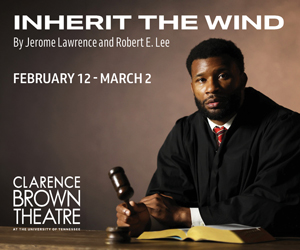It is said that there is a moment in a person’s life—usually in the adolescent or teenage years—when music begins to speak to them in a personal way, with that specific music magically acting as a gravitational force on their musical taste for the rest of their lives. For many born in the late 1930s and 40s, their musical age grew wildly out of the post-war cultural divergences of the 1950s and a musical backbone of gospel and rhythm and blues. Rock n’ roll was born, and as we know, rock n’ roll never dies.
There is ample justification for claiming that rock and roll began at the Sun Records studio in Memphis with owner/producer Sam Phillips, a man on a quest to bring the sound and feel of black music to a broader audience. Capturing a seminal moment in that quest is the musical Million Dollar Quartet that opened on Friday evening at Clarence Brown Theatre. It is simply impossible to resist this immensely energetic and rhythmically-infused songbook show created by Colin Escott and Floyd Mutrux that focuses on a single afternoon, Dec. 4, 1956, at Phillips’ Sun Studio. It was there that music history was made in a jam session of music and banter by four artists still on their way upward to stardom: Jerry Lee Lewis, Carl Perkins, Johnny Cash, and Elvis Presley.
Directed by Kate Buckley with musical direction by Kory Danielson, much of the fun of Million Dollar Quartet lies not only in the overwhelming wealth of songs included in the show, but also in the dynamics of the performers. Songs like “Blue Suede Shows,” “Great Balls of Fire,” “Folsom Prison Blues,” “Hound Dog,” “That’s All Right” are backed up by the gospel genesis of the beautifully harmonized “Down by the Riverside” and “Peace in the Valley.” But, it is the ability of these performers—Sean McGibbon as Jerry Lee Lewis, Chance Wall as Carl Perkins, Peter Oyloe as Johnny Cash, and Kavan Hashemian as Elvis Presley—that breathes life into the music and their characters. McGibbon, in particular, takes advantage of his bright and physically ostentatious character and delivers a piano-banging, show-stopping, and likably cocky, “balls of fire” performance.

The thematic glue of Million Dollar Quartet comes from the character of Sun Studio producer Sam Phillips (Levi Kreis) who acts as narrator, laying down bridges of narrative information between the songs—his discoveries of the boys, their personalities, and how it all led up to the present. Interestingly, Kreis has had a substantial history with this show, taking the role of Jerry Lee Lewis in the original Chicago production followed by the 2010 Broadway production, receiving a Tony Award for his trouble.
Another interesting historical inclusion is the character of the quasi-fictional “Dyanne”, a supposed girlfriend of Presley who accompanied him to the studio, and whose voice is heard on the afternoon’s tape and whose image is seen in the photograph marking the occasion. Since the original opening of the Million Dollar Quartet, “Dyanne” has been revealed to be the real-life Marilyn Evans (now Marilyn Knowles-Riehl), a young woman working as a showgirl in Las Vegas during the time Elvis first worked there. (While Evans accompanied Elvis to Memphis for a visit, they only dated briefly.) “Dyanne” (Missy Wise) gets her own numbers in the show, delivering a sensationally steamy version of “Fever” and a rollicking “I Hear You Knocking.”
In addition to the quartet singing and playing their own instruments—Wall recreating Perkins’ rockabilly guitar style, McGibbon on piano (sometimes literally), and Oyloe and Hashemian on acoustic guitars—the band is backed up by some great work by Perkins’ brother on bass (Zach Lentino) and Fluke (Andrew Kuenzi) on drums.
With all the nostalgic beat and foot-wagging rhythm emanating from the show, it’s easy to willingly overlook the necessary formulaic constructions of the expositional back story. Phillips has recently sold Elvis’s contract to RCA in return for the funds to keep Sun Studio in business. Johnny Cash’s career has taken off, but his contract with Phillips is about to expire. Perkins has had a hit with “Blue Suede Shoes,” but has been struggling to repeat. Phillips has invited Lewis in to add some piano interest to Perkins’ performance, a fact that screams the tension of contrasting personalities and styles of the two performers. And, although the show’s narration implies a tearful conflict of breakout stars disloyally leaving the producer who discovered them, the fact is that Phillips and Sun Records did alright going forward.
Narrative aside, though, Million Dollar Quartet is a feast for rock n’ roll aficionados and music lovers of all types. In the finale, we get a scenic glimpse of what lies ahead for rock n’ roll as a modern lighting truss flies in and the 1950s studio set is suddenly outlined in chaser lights and filled with saturated colors (scenic designer Katharine Stepanek and lighting designer Kirk Bookman). The performers exchange their street clothes for appropriately glitzy outfits (costume designer Lauren T. Roark) and turn the heat up a notch or two in a powerful performance of “A Whole Lot of Shakin’ Goin’ On.”
Did that afternoon session with Presley, Perkins, Lewis, and Cash change anything in rock history? Probably not. Still, we love to visualize what that day may have been like and hope that there really was magic in the lives of four talented musicians. After all, that magic lives on in their music.






